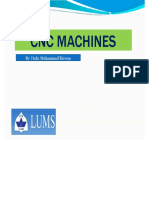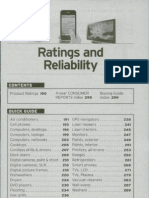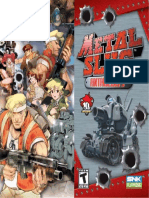0 ratings0% found this document useful (0 votes)
132 viewsNC & CNC
NC & CNC
Uploaded by
Arun Kumar1. NC (Numerical Control) machines use programs of letters, numbers, and symbols to control a process, making it flexible to change programs for different jobs.
2. The basic components of an NC system are the program of instructions, the machine control unit, and the machine tool or other controlled process. The program tells the controller what to do via punched tape or other input methods.
3. The machine control unit reads and interprets the program, converting it into mechanical actions for the machine tool via elements like a tape reader, data buffer, signal channels, and sequence controls.
Copyright:
© All Rights Reserved
Available Formats
Download as DOC, PDF, TXT or read online from Scribd
NC & CNC
NC & CNC
Uploaded by
Arun Kumar0 ratings0% found this document useful (0 votes)
132 views3 pages1. NC (Numerical Control) machines use programs of letters, numbers, and symbols to control a process, making it flexible to change programs for different jobs.
2. The basic components of an NC system are the program of instructions, the machine control unit, and the machine tool or other controlled process. The program tells the controller what to do via punched tape or other input methods.
3. The machine control unit reads and interprets the program, converting it into mechanical actions for the machine tool via elements like a tape reader, data buffer, signal channels, and sequence controls.
Original Description:
CNC
Copyright
© © All Rights Reserved
Available Formats
DOC, PDF, TXT or read online from Scribd
Share this document
Did you find this document useful?
Is this content inappropriate?
1. NC (Numerical Control) machines use programs of letters, numbers, and symbols to control a process, making it flexible to change programs for different jobs.
2. The basic components of an NC system are the program of instructions, the machine control unit, and the machine tool or other controlled process. The program tells the controller what to do via punched tape or other input methods.
3. The machine control unit reads and interprets the program, converting it into mechanical actions for the machine tool via elements like a tape reader, data buffer, signal channels, and sequence controls.
Copyright:
© All Rights Reserved
Available Formats
Download as DOC, PDF, TXT or read online from Scribd
Download as doc, pdf, or txt
0 ratings0% found this document useful (0 votes)
132 views3 pagesNC & CNC
NC & CNC
Uploaded by
Arun Kumar1. NC (Numerical Control) machines use programs of letters, numbers, and symbols to control a process, making it flexible to change programs for different jobs.
2. The basic components of an NC system are the program of instructions, the machine control unit, and the machine tool or other controlled process. The program tells the controller what to do via punched tape or other input methods.
3. The machine control unit reads and interprets the program, converting it into mechanical actions for the machine tool via elements like a tape reader, data buffer, signal channels, and sequence controls.
Copyright:
© All Rights Reserved
Available Formats
Download as DOC, PDF, TXT or read online from Scribd
Download as doc, pdf, or txt
You are on page 1of 3
NC MACHINES
NUMERICAL CNTROL NC:
NC is defined as a form of programmable automation in which the process is
controlled by letters, numbers, & symbols.
Here the numbers form the program of instructions.
NC is flexible, because hanging the program for each new job/ part is very
easy.
pplications! "rafting, assembly, inspection, sheet metal, spot welding &
machining #"rilling, boring, grinding, $urning, %illing, &awing'.
A -BASIC COMPONENTS OC NC SYSTEM:
(ollowing are the three components of NC systems
). *rogram of instructions #*+,'.
-. %achine Control unit #%C.'.
/. %achine tool & 0or0 other controlled processes.
Program of instructions: refers to set of directions, which tell the computer what to
do.
$he most common type of input medium used is 1$he *unched $ape2. +thers forms
of input include magnetic tape, /3 mm motion picture film.
%ethods of input!
i. %anual "ata ,nput #%",'! .sed for simple jobs.
ii. "irect Numeric Control #"NC'! .sed for complex jobs.
$he program of instructions are prepared by 4*art *rogrammer5
Macin! contro" Unit: Consists of electronic & hardware that read and interpret the
program of instructions and convert it into mechanical actions of machine tool.
6lements of %C.!
$ape reader, "ata buffer, &ignal +/p channels, & se7uence controls.
Tape reader is a electromechanical device for winding and reading the punched tape
containing *+, #*rogram +f ,nstructions'.
$he purpose of Data Buffer is to store i/p instructions in logical bloc8s of information.
Signal o/p channels are connected to servomotors and other controls in machine tool.
$hrough these channels, instructions are sent to machine tool from controller unit
nother element of NC system is the Control Panel which consists of "ials and
switches to run the system.
Macin! too" #roc!ss: performs useful wor8
,t consists of wor8table and spindle, motors and controls necessary to drive them.
,t also includes cutting tools, wor8 fixtures and auxiliary e7uipments necessary for
machining operations.
B -THE NC COOR$INATE SYSTEMS:
$he wor8 piece is always stationary and the tools moves. $he purpose of coordinate
system is to provide a means of locating the tool in relation to the wor8 piece.
). (ixed 9ero and (loating 9ero! Here the 9ero is fixed and all other tool locations are
specified/ defined by positive : & ; coordinates.
,n (loating 9ero the <ero point is set at any convenient position on the
machine table as per the part programmers convenience.
-. bsolute positioning & ,ncremental positioning!
,n bsolute positioning the tool locations are always defined wrt <ero point.
,n ,ncremental positioning the tool location are defined wrt previous tool location.
C % NC MOTION CONTROL SYSTEMS:
,n NC there are three types of motion control systems
). *oint0to0*oint #*$*'.
-. &traight cut.
/. Contouring.
*$* represent the lowest level of motion control between the tool and wor8 piece,
while the contouring represent the highest level.
). *oint0to0*ont #*$*'! $his is also called *ositioning system. Here the objective of
machine tool control system is to move the cutting tool to a predefined location.
6x! NC drill presses.
&uitable for drilling as well as spot welding processes.
-. &traight0cut NC! are capable of moving the cutting tool parallel to one of the major
axes at a controlled rate suitable for machining. $hese are also capable of performing
*$* movements. =ith this type of NC system it is not possible to combine
movements in more than one direction.
&uitable for milling operations.
/. Contouring NC! $his is also called Continuous path NC systems. ,t is the most
complex, most flexible and most expensive type of machine tool control. ,t is capable
of performing both *$* & &traight0cut operations. $he distinguishing feature of
0 1 2 3 4 5 6 7 8 9
1
2
3
4
5
6
7
8
9
x=2
y=3
(4,5)
(6,8)
Specify x= 6, y= 8
(Absolute positionin)
(!nc"e#ent$l positionin)
Specify x= 2, y= 3
A%&S'()* +s !,-.*/*,)A' 0&S!)!&,!,1
Contouring NC is their capacity for simultaneous control of more than one axis
movement of machine tool.
b
0&!,) )& 0&!,) ,- S2S)*/
S).A!13) -() ,- S2S)*/
St$"tin point -utin tool
4o"5piece
S6itc7 to
-i"cul$" inte"pol$tion
-u"8e
St"$i7t cut
#o9e
-&,)&(.!,1 ,- S2S)*/
You might also like
- CNC Router Essentials: The Basics for Mastering the Most Innovative Tool in Your WorkshopFrom EverandCNC Router Essentials: The Basics for Mastering the Most Innovative Tool in Your WorkshopRating: 5 out of 5 stars5/5 (3)
- CNC MaintenanceDocument206 pagesCNC MaintenanceArjun M Betageri100% (3)
- Draft Offshore ChecklistDocument2 pagesDraft Offshore Checklistmohamad nur saufi0% (1)
- Compal La-B111p r1.0 Lenovo Y50-70schematics PDFDocument59 pagesCompal La-B111p r1.0 Lenovo Y50-70schematics PDFgrafikkoNo ratings yet
- CADCAM CNC Unit-3.2Document45 pagesCADCAM CNC Unit-3.2kiranchennoju2004No ratings yet
- CAD Assignment IIDocument17 pagesCAD Assignment IIBappi ChamuaNo ratings yet
- Numerical ControlDocument10 pagesNumerical ControlDevarajanRaghavanNo ratings yet
- Lec.02 Programming of Manufacturing CellsDocument28 pagesLec.02 Programming of Manufacturing CellsAmer Abd EL-hkimNo ratings yet
- CNC Ipme 710Document73 pagesCNC Ipme 710vajram1No ratings yet
- Numerical ControlDocument37 pagesNumerical ControlRammohan ReddyNo ratings yet
- CNC Turning Programming Fundementalsls, Step by StepDocument14 pagesCNC Turning Programming Fundementalsls, Step by Stepschriener50% (2)
- Unit 5 Me1203Document25 pagesUnit 5 Me1203Muthuvel M100% (1)
- Ch_6 Computer Numerical Control(1)Document59 pagesCh_6 Computer Numerical Control(1)Do Thi My LeNo ratings yet
- Classification of NCDocument9 pagesClassification of NCAmarnadh60% (5)
- Cad/Cam: NC, CNC, DNC TechnologiesDocument37 pagesCad/Cam: NC, CNC, DNC TechnologiesVijay ShakarNo ratings yet
- Cim and Automation LabDocument23 pagesCim and Automation LabAnilKotthurNo ratings yet
- Unit - Iv Introduction and Concepts of NC/ CNC MachineDocument15 pagesUnit - Iv Introduction and Concepts of NC/ CNC MachineAbhi RamNo ratings yet
- CNC Machines: Presentation OnDocument37 pagesCNC Machines: Presentation OnNUHMAN M ANo ratings yet
- Bme Lecture CNCDocument18 pagesBme Lecture CNCRoop LalNo ratings yet
- CAD-CAM Power Point PresentationDocument102 pagesCAD-CAM Power Point PresentationArgAshishGargNo ratings yet
- Cim Lab ManualDocument51 pagesCim Lab ManualYashas0% (1)
- NC and CNC MachinesDocument25 pagesNC and CNC MachinesSabiha Hajdarbegović-HafizovićNo ratings yet
- Introduction To NC - CNC MachinesDocument40 pagesIntroduction To NC - CNC MachinesMEET BHANUSHALI 19BMA0061No ratings yet
- NC & CNCDocument29 pagesNC & CNCtve21ie060No ratings yet
- Title Objective: Figure 1: Hitachi Seiki Hitec-Turn20SiiDocument11 pagesTitle Objective: Figure 1: Hitachi Seiki Hitec-Turn20SiiSilang KataNo ratings yet
- Study of CNC MachinesDocument53 pagesStudy of CNC MachinesPreethi VadivelNo ratings yet
- UNIT-II-Manual Part Programming and RoboticsDocument151 pagesUNIT-II-Manual Part Programming and RoboticsSwarna PaulNo ratings yet
- Computer Numerical Control Systems (CNC)Document13 pagesComputer Numerical Control Systems (CNC)lucasNo ratings yet
- Lecture Notes On CNCDocument125 pagesLecture Notes On CNCniteen_mulmule48580% (5)
- NC & CNC MachinesDocument12 pagesNC & CNC MachinesRenjith Rajendraprasad100% (1)
- CNCDocument76 pagesCNCAlexandru Precup100% (1)
- CNC ManualDocument49 pagesCNC ManualThiagarajan VenugopalNo ratings yet
- Lec 6 Numerical Control SystemDocument59 pagesLec 6 Numerical Control SystemProff Moffat JamesNo ratings yet
- Unit 1 Part 1.2Document6 pagesUnit 1 Part 1.2Abhishek KumarNo ratings yet
- 2. Numerical ControlDocument53 pages2. Numerical Controlme341.spring.2023No ratings yet
- Unit IiiDocument30 pagesUnit IiiSai Syam RallabhandiNo ratings yet
- 9.pmat M-01Document94 pages9.pmat M-01mailtome126100% (1)
- Chapter Motion and Control SystemDocument13 pagesChapter Motion and Control SystemRavinder SinghNo ratings yet
- Closed-Loop Positioning SystemsDocument25 pagesClosed-Loop Positioning Systemsfarah nazNo ratings yet
- Aim: To Study About NUMERICAL CONTROL (NC) Machine ToolsDocument9 pagesAim: To Study About NUMERICAL CONTROL (NC) Machine ToolsNidal BestNo ratings yet
- Manufacturing Technology (ME461) Lecture10Document16 pagesManufacturing Technology (ME461) Lecture10candypop8725No ratings yet
- Me8451 LN 233 258Document26 pagesMe8451 LN 233 258hariharankb.mechNo ratings yet
- CNC MachineDocument70 pagesCNC Machinejacky hansdah100% (1)
- Metal Cutting and Machine Tools Unit 5Document21 pagesMetal Cutting and Machine Tools Unit 5Thilagavathi RajaNo ratings yet
- Instituto Tecnologico de Tlalnepantla: Manufactura AvanzadaDocument55 pagesInstituto Tecnologico de Tlalnepantla: Manufactura AvanzadaElizabeth HernandezNo ratings yet
- CH 3-CNC Machine ToolsDocument39 pagesCH 3-CNC Machine Toolsdejenem398No ratings yet
- CNC Part ProgrammingDocument53 pagesCNC Part ProgrammingmsshahenterNo ratings yet
- CNC Part ProgrammingDocument40 pagesCNC Part ProgrammingmsshahenterNo ratings yet
- CNC Lathe Machine ProjectDocument8 pagesCNC Lathe Machine ProjectNisar Hussain67% (3)
- Numerical ControlDocument36 pagesNumerical ControlsaishvNo ratings yet
- CIM Notes TypedDocument9 pagesCIM Notes TypeditzgayaNo ratings yet
- CH 4Document44 pagesCH 4abhu8055No ratings yet
- CNC TechnologDocument115 pagesCNC TechnologMuthish ThangamNo ratings yet
- Computer and Numerically Controlled Machines Numerically Controlled (NC)Document7 pagesComputer and Numerically Controlled Machines Numerically Controlled (NC)pranav29No ratings yet
- The Basics of The Core of CNC Machine tool-CNC Unit: Functions Working Principles Hardware Configuration and Software StructureDocument66 pagesThe Basics of The Core of CNC Machine tool-CNC Unit: Functions Working Principles Hardware Configuration and Software StructureYohannes GebreNo ratings yet
- Group TechnologyDocument33 pagesGroup Technologyglalitkumar143No ratings yet
- Unit-V PTAMDocument71 pagesUnit-V PTAMculvertsNo ratings yet
- Chapter 7 A GrooverDocument10 pagesChapter 7 A GrooverSyma ShaheenNo ratings yet
- The Basics of The Core of CNC Machine tool-CNC Unit: Functions Working Principles Hardware Configuration and Software StructureDocument66 pagesThe Basics of The Core of CNC Machine tool-CNC Unit: Functions Working Principles Hardware Configuration and Software StructureVinit BhardwajNo ratings yet
- Experiment No 6Document11 pagesExperiment No 6harisraja47985No ratings yet
- Shortlisted Candidates For The SRF InterviewDocument2 pagesShortlisted Candidates For The SRF InterviewArun KumarNo ratings yet
- Irctcs E-Ticketing Service Electronic Reservation Slip (Personal User)Document1 pageIrctcs E-Ticketing Service Electronic Reservation Slip (Personal User)Arun KumarNo ratings yet
- Bellary Telecom DistrictDocument3 pagesBellary Telecom DistrictArun KumarNo ratings yet
- Visvesvaraya Technological University, Belagavi, Karnataka: Full Time Part TimeDocument7 pagesVisvesvaraya Technological University, Belagavi, Karnataka: Full Time Part TimeArun KumarNo ratings yet
- Solatube: Innovation To Day LightingDocument2 pagesSolatube: Innovation To Day LightingArun KumarNo ratings yet
- Abstract-Recently Multilevel Inverters (Mlis) Got Wide Popularity As It Gives Much Similarity in The Output VoltageDocument3 pagesAbstract-Recently Multilevel Inverters (Mlis) Got Wide Popularity As It Gives Much Similarity in The Output VoltageArun KumarNo ratings yet
- M.tech Syllabus PDFDocument51 pagesM.tech Syllabus PDFAnonymous MR8PLYNo ratings yet
- Tools List: Face Mill Side Milling Pocket Milling Pocket Milling Drill DrillDocument1 pageTools List: Face Mill Side Milling Pocket Milling Pocket Milling Drill DrillArun KumarNo ratings yet
- Consumer Reports BuyingGuide 2010 - All Product RatingsDocument107 pagesConsumer Reports BuyingGuide 2010 - All Product Ratingsdesijnk100% (2)
- Campro Engine Manual PDF: Mirror Link #1Document3 pagesCampro Engine Manual PDF: Mirror Link #1Adzz Wnz Sha100% (1)
- Advanced Prokopack by insectPRODocument2 pagesAdvanced Prokopack by insectPROItrux jonathan cisnerosNo ratings yet
- 55XX Service 100115Document573 pages55XX Service 100115Luis GonzalezNo ratings yet
- ReadmeDocument3 pagesReadmeSaulo RuizNo ratings yet
- DRC LayersDocument19 pagesDRC LayersRaul Sanchez RoyNo ratings yet
- Asus-Eee PCDocument1 pageAsus-Eee PCRichard MacNo ratings yet
- Computer Organization and Architecture: Ashok Kumar TurukDocument54 pagesComputer Organization and Architecture: Ashok Kumar TurukSatya DasNo ratings yet
- NAV350 Operating ManualDocument70 pagesNAV350 Operating ManualthaisubNo ratings yet
- Memory RAM, ROM and Memory Systems: Slides of Adam Postula UsedDocument35 pagesMemory RAM, ROM and Memory Systems: Slides of Adam Postula Usedmaheshvarma876No ratings yet
- MANUALMBEDocument264 pagesMANUALMBEAna Lorca90% (10)
- Dspic33 SpiDocument30 pagesDspic33 Spidanielrb18No ratings yet
- Metal Slug Anthology PSP Guide - 2007 - Ignition EntertainmentDocument9 pagesMetal Slug Anthology PSP Guide - 2007 - Ignition EntertainmentGarox KunNo ratings yet
- Huawei CloudEngine 1800V Virtual Switch Data SheetDocument8 pagesHuawei CloudEngine 1800V Virtual Switch Data Sheetpmedinacu100% (1)
- Z SpecificationDocument17 pagesZ SpecificationMujtaba TariqNo ratings yet
- Debug 1214Document3 pagesDebug 1214LarisssaaNo ratings yet
- J.2 Table of Codes: ACUCOBOL-GT AppendicesDocument4 pagesJ.2 Table of Codes: ACUCOBOL-GT AppendicesAntonio BarbosaNo ratings yet
- Change HP MergerDocument14 pagesChange HP MergerKhalil Nsour100% (1)
- HCIA-Datacom V1.0 Equipment ListDocument14 pagesHCIA-Datacom V1.0 Equipment ListmeditarukNo ratings yet
- Computer Overview: BY Priya Sharma XI - F'Document29 pagesComputer Overview: BY Priya Sharma XI - F'Priya SharmaNo ratings yet
- Triac BT137-600DDocument6 pagesTriac BT137-600DEverton AlvesNo ratings yet
- 0705revd - Contents, SVC Man, Passport V PDFDocument134 pages0705revd - Contents, SVC Man, Passport V PDFdido fidoNo ratings yet
- ABAP Words: ABAP Language Elements ABAP Language Element AdditionsDocument6 pagesABAP Words: ABAP Language Elements ABAP Language Element AdditionsAlyDedenNo ratings yet
- MGB L0HB Pna R 113232Document5 pagesMGB L0HB Pna R 113232Cosmin ManoleNo ratings yet
- Product Guide: Direct Contact Liquid Cooling (DCLC)Document12 pagesProduct Guide: Direct Contact Liquid Cooling (DCLC)ihabosmanNo ratings yet
- 6.813/6.831 - User Interface Design and Implementation: Due Session 26Document3 pages6.813/6.831 - User Interface Design and Implementation: Due Session 26Diman IonutNo ratings yet
- Blender Bmesh Data StructureDocument10 pagesBlender Bmesh Data StructureJoshua SmithNo ratings yet
- Advantage NEMADocument28 pagesAdvantage NEMAJorge Sebastian Cifuentes UnibazoNo ratings yet

































































































